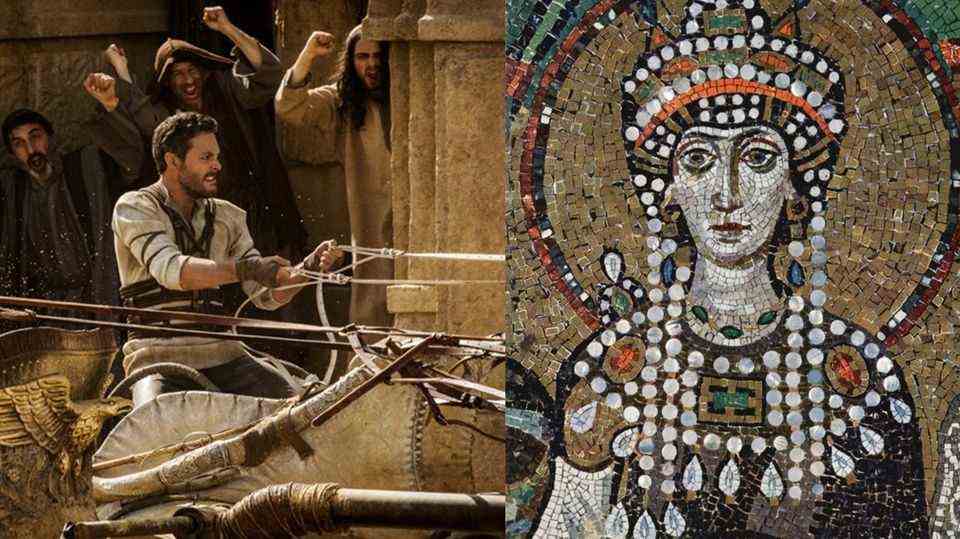Find on Gotland
Magnificent earring – why a piece of jewelery from the emperor adorned the neck of a beautiful Viking woman
The earring survived almost unscathed, only the enamel got small cracks.
© Mette Klüver Rongsted / Danish National Museum / PR
A beautiful earring was found in a field in Jutland. Presumably a gift from the Byzantine emperor. Such a gift was only given for very special services.
This magnificent and valuable earring once adorned the neck of a Viking woman. Experts believe it belonged to the Emperor of Byzantium, today’s Istanbul. The powerful ruler of the Eastern Roman Empire is said to have given it as a thank you to a warrior chief.
Finds from the Mediterranean are not uncommon in Scandinavia, but this magnificent piece is one of a kind. It was made in the 11th century and discovered by a treasure hunter’s probe in a field in West Jutland, Denmark. The photos of the Danish National Museum show how a restorer processes and cleans the piece (see photo gallery). Then it came to the museum’s Viking exhibition.
The second ring was lost
After the find, the field was meticulously searched, but unfortunately the second earring was not found. “We only know of ten to twelve other specimens of this species worldwide, and we have never found one in Scandinavia,” said Peter Pentz, inspector at the National Museum of Denmark. “We expected to find such a beautiful and priceless piece of jewelry together with a great gold pot or in a royal tomb and not in a field.”
The 54-year-old Frants Fugl Vestergaard had found the ring. He had combed the field several times. He told the National Museum that his detector made a faint beep, then he grabbed a clod of earth, crushed it, and had the earring in his hand. “Then time stopped for me. I became humble and wondered why I was allowed to find this piece. You always long to find something so beautiful, a lace find, and then suddenly you have it in your hands. That is completely unimaginable. “
How the find got there is unknown. But since it was not protected by a jug or casket, it will not have been deliberately deposited there. The jewelry consists of a crescent-shaped gold plate, which is inserted into a frame of gold threads. Gold balls and gold ribbons decorate the pendant. The greatest specialty is the enamel. Their production was only mastered in a few places. For this purpose, glass was ground to powder and then fused together with metal. The enamel shows two stylized birds and a plant that symbolizes the tree of life. This type of jewelry is known from Egypt and Syria, as well as from Byzantium and Russia. The object was so valuable that it couldn’t be bought. Such pieces were made for high-ranking people and only passed on as gifts.
Way across the rivers
The only question is how did it get from the Mediterranean to Scandinavia? The Vikings were not only robbers, slave hunters and warriors, but above all traders. In the Middle Ages they traveled the known world. However, they did not reach the Mediterranean via the well-known sea route through the rough Biscay and the Strait of Gibraltar, but rivers led them through Eastern Europe to the Black Sea. The Arab Al-Mas’udi called the Vikings the “masters of the Black Sea” and states that they “brought their ships with them” when they traded.
The emperor’s bodyguards
On the way there, they founded the Kievan Rus. In Byzantium, the fighters served the Emperor of Constantinople in the war and also as bodyguards. They carried on a long tradition. Even the first emperors of Rome did not allow themselves to be protected by the Praetorian Guard alone; they hired Teutons from the north for their immediate protection. The bodyguard should consist of strangers who had no connection to Roman society. The bodyguards from the north were considered incorruptible. They were ready to fight for their master even in a hopeless situation and to follow him to his death. This tradition was continued by the Northmen. The mysterious and dark massacre of Sandy Borg, in which an entire small town was massacred, is said to have been committed by returnees who returned to the north after the collapse of the Western Roman Empire.
The Varangian Guard
The emperors of Byzantium not only had a bodyguard, they hired the mighty fighters to reinforce their own troops. The Varangian Guard existed from the tenth to the fourteenth centuries. The first guard was already in service in 874. In Byzantium they were recognized by their long hair and a red ruby in their ears. They carried an ornate dragon on their chests. In the battle, the guards would deliver the decisive blow. Chroniclers wrote that “the Scandinavians were terrifying in both appearance and equipment. They attacked with ruthless anger, caring about blood loss and wounds.” A tradition of their legal customs is known. A Varangian tried to rape a Thracian woman. But she resisted and impaled the warrior with a spear. The dead man’s comrades did not seek revenge on the woman, but praised her courage. Then they gave her the property of the man she won in battle.
When the Crusaders sacked Byzantium, the Varangians offered dogged but ultimately unsuccessful resistance on the walls of the city. Such service for the emperor was not only paid for with wages. The close connection between a Viking tribe and the imperial family was woven through gifts. Gifts were not simply a gift, they were an honor and an obligation on both sides. The more outstanding the gift, the closer the bond. This explains how such a valuable piece of jewelery came to be found in a field in Jutland.
Also read:
Researchers decipher the natural drug that turned Vikings into wild berserkers
Greek fire: how the ancient napalm protected Byzantium for 800 years
“Game of Thrones” in Sweden – Middle Ages massacre wiped out entire village





